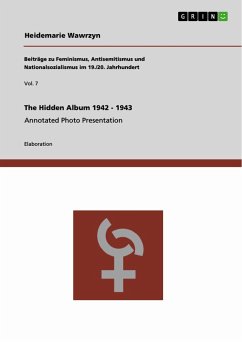Document from the year 2014 in the subject History Europe - Germany - National Socialism, World War II, , language: English, abstract: Beiträge zu Feminismus, Antisemitismus undNationalsozialismus im 19./20. Jahrhundert: Vol 7.The planned presentation has been written on the occasion of International Holocaust Remembrance Day. The starting point of the project was the discovery of a hidden military album including photos of Belarus and Russia in 1942/43. Many German soldiers kept photo albums to commemorate their "glorious days" in World War II. They had been in places where German killing units - Einsatzgruppen - had murdered Jews, Communists and anyone opposed to their advance. In towns like Grodno, Baranowicze, Bobruisk, Orel, and Briansk - hardly household names - Jews were sent to ghettos, forced into labor service, and routinely rounded up and massacred. The Einsatzgruppen and the German Army worked together. By spring 1943, approximately 1.25 million Jews were dead.The annotated photo presentation displays twenty-four black and white photographs. Looking closely at one snapshot, the reader can see yellow badges on the coats of women holding shovels in their hands. On the same page, a soldier is laughingly pulling a woman away from a truck. What is the background to these pictures? What had happened there? The author tries to find answers to these questions - questions which are difficult to solve almost seventy years after the Holocaust.








